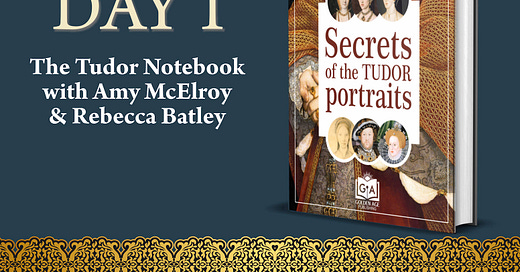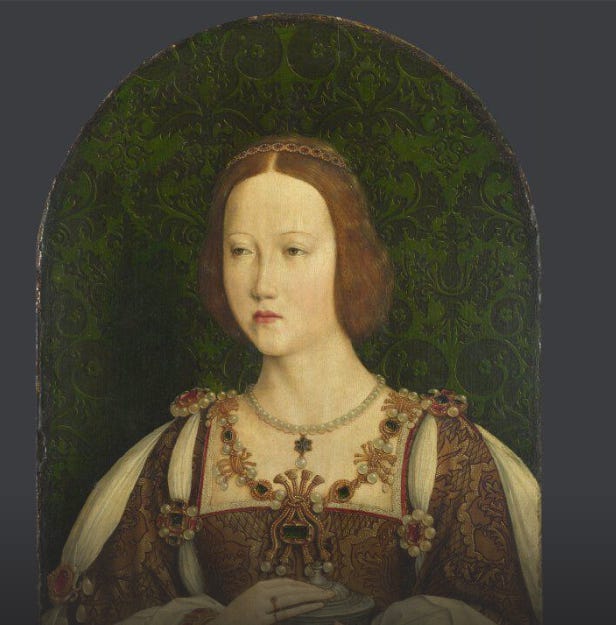Portraiture of Mary Tudor, Dowager Queen of France & Duchess of Suffolk
Guest post from Sylvia Barbara Soberton
To celebrate the publication of Secrets of the Tudor Portraiture, we welcome Sylvia Barbara Soberton to The Tudor Notebook.
In this article, I’m going to take a closer look at the portraiture of Henry VIII’s younger sister, Mary Tudor (1496-1533).
“Handsome and well-favoured”
Mary was widely praised for her good looks and impeccable manners. She was “of handsome presence, not stout, has a beautiful face, and is cheerful”. She was considered “handsome and well favoured, were not her eyes and eyebrows too light”. This may indicate that she shared her brother’s fair skin, bright eyes and red hair. Mary is depicted as a redhead with fair skin and red cheeks in a manuscript commemorating her marriage to Louis XII in 1514 (picture 1).
Mary’s portrait in Margaret of Austria’s collection
One of the earliest references to Mary’s portrait comes from June 1514 when Gerard de Pleine, ambassador of Charles of Castile’s aunt Archduchess Margaret of Austria, reported that the painter whom Margaret sent to England “has made a good likeness of Mary”. The painter in question was most likely Michel Sittow, who had resided at Margaret of Austria’s court since 1504. Margaret owned at least two representations of Mary Tudor that are recorded in her inventory: one a terra-cotta bust and the other a portrait. The now lost portrait showed Mary dressed in a black velvet gown and wearing a golden cap on her head, holding a parrot in her hand. Margaret was interested in Mary’s appearance because Mary was engaged to Charles of Castile (future Emperor Charles V), Margaret’s nephew.
Album d’Aix
A sketch of Mary in the Album d’Aix, where the most important personages of the French court were depicted, was inscribed by Francis I with the words: Pleus folle que royne (picture 2). It has been incorrectly translated into English as “more dirty than queenly”; the more accurate translation would be “more fool than a queen”. Francis’s opinion about Mary was coloured by her hasty and scandalous remarriage to Charles Brandon, Duke of Suffolk, within a month of Louis XII’s death. The sketch in the Album d’Aix shows Mary wearing a white cap on her head, with strands of light, wavy hair tucked beneath. Two late sixteenth-century copies are preserved in the Ashmolean Museum, but it is the sketch from the Album d’Aix that is the most accurate one as it was painted from life.
Isabella of Castile or Mary?
A portrait purportedly depicting Mary Tudor has long been preserved in the vaults of the National Gallery in London, and graces many covers of her biographies (picture 3). The portrait depicts a red-haired woman with green-blue eyes on a background of green brocade. She is painted in the guise of Mary Magdalene holding an ointment jar, the saint’s unmistakable attribute. Her dress is made of cloth-of-gold brocade and is fastened with pins of gold, pearls, rubies and sapphires. The sitter wears a diadem set with rubies and pearls on her head and a pearl necklace with a star-shaped sapphire pendant suspended from it. She has an opulent golden necklace with pearls and emeralds hanging across her shoulders and chest. Her tapering fingers are decorated with small pearl-and-ruby golden rings, and she wears a bracelet set with rubies on her left hand. A handwritten nineteenth-century label on the back of the picture identifies the sitter as Mary Tudor, Dowager Queen of France and Duchess of Suffolk, but other sitters were proposed as well.
The painting is now labelled as “the Magdalen”, St Mary Magdalene. In 2012, Portuguese art historian Pedro Flor suggested that the sitter in the portrait is not Mary Tudor, but Isabella of Castile, Queen regnant of Spain and mother of Henry VIII’s first wife, Katharine of Aragon. Flor identified the sitter as Isabella of Castile thanks to the luxurious necklace she wears in the portrait, as well as the portrayed woman’s physique. Isabella of Castile was a beauty when she was younger, and the sitter bears resemblance to the Queen.
A double portrait of Mary Tudor and Charles Brandon
One of the most famous depictions of Mary comes from a double portrait of her and Charles Brandon (picture 4). Often referred to as their wedding portrait, it has been dated to 1515 and attributed to the Flemish painter Jan Gossaert. Recent research, however, suggests 1532 as the likelier date for the portrait, based on the details of the sitters’ clothing aligning with fashions worn at the Tudor court around that period and the unlikelihood that the portrait would have been painted during the turbulent year of their wedding.
The Sudeley Castle portrait
A portrait of Mary, attributed to the Flemish artist Johannes Corvus, still hangs at Sudeley Castle (picture 5). It has the Latin inscription that identifies the sitter as Mary: Maria Soror Illustrissimi Regi Henrico Viii Ac Gallorum Regina Coniunxque Illustri Principi Carolo Duci Suffolcia Ano Aetatis Svae Xxxiiii, which means “Mary sister of the illustrious King Henry VIII and Queen consort of France; wife of the illustrious prince Charles Duke of Suffolk, at the age of thirty-eight”.
The Southwick Hall portrait
A portrait of Mary Tudor was once on display at Southwick Hall. It was paired with Charles Brandon’s painting that is now held in the National Portrait Gallery in London. Mary’s portrait from Southwick is now presumed lost or held in a private collection. Luckily, the Southwick portrait was sketched before it went missing (picture 6). It shows Mary dressed in an opulent gown with a square, low-cut and embroidered neckline. She wears a richly bejewelled English gable hood and has a necklace with a circular medallion depicting the crucified Christ suspended from it. Another circular medallion with a single pendant pearl is pinned to her bodice. She holds a little book, most likely a devotional text, in her left hand. The Latin inscription identifies the sitter as Mary: Maria Regina Fra Et D Suffoltia, meaning “Mary Queen of France and Duchess of Suffolk”, and Filia H Sep Regis Angliae, meaning “daughter of Henry VII King of England”. In 1805, when the sketch of the painting was included in the Gentleman’s Magazine, the portrait still hung in Southwick Hall.
If you found this article intriguing, you’ll love my book! Secrets of the Tudor Portraits is out now—unravel the hidden stories behind these iconic works of art. Get your copy today!
We hope you have enjoyed this post from Sylvia! You can click on the link above to order your copy!













Secrets of the Tudor Pictures is next on my list to read. Right now I’m reading about the Bayeux Tapestry.
🏵️😻Is it possible that the Sudeley and Southwick portraits are Katherine of Aragon?,especially the Southwick one.Facially they look to be the same woman,but the Southwick it looks as if she has pomegranates and pomegranate flowers decorating her neckline.The lost portrait which belonged to Margaret of Austria I translated from the inventory written in french that she was holding a palm leaf.Not sure how accurate Google translate is .I believ Mary Tudor/Brandon was described like Jane Seymour has being very fair skinned and light coloured eyes.The wedding portrait of Mary and Charles Brandon is noticeable for her dark hair and eyes,more how you would imagine Anne Boleyn.